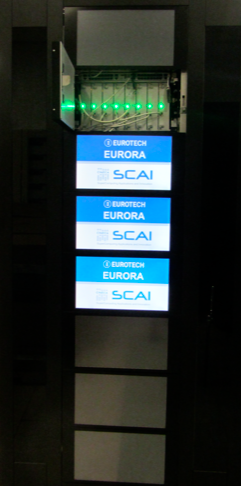You are here
New Intel Xeon Phi available in Eurora

“Equipped with the ultra-efficient Aurora system and NVIDIA Tesla K20 accelerators, now together with INTEL Xeon Phi cards, Eurora will give European researchers the computing power to study all types of physical and biological systems, while allowing us - says Sanzio Bassini, Head of the HPC Department at Cineca - to keep data center power consumption and costs incheck”
With one complete chassis, 8 nodes each one with 2 Phi cards, and the already installed K20, Eurora currently offers the most advanced technology as to graphics co-processors.
We expect 3 further chassis by the half of August, for a total of 48 new Xeon Phi.
In the August configuration Eurora will have 64 Intel Xeon Phi cards plus 64 NVIDIA Tesla K20 cards.
Each Intel Xeon Phi card installed in EURORA consists of one dense form factor Intel Xeon-Phi 5120D 1.053GHz coprocessor providing:
- 60 computing cores (240 threads)
- 8 GBytes RAM
and is capable of:
- 352 GBytes/s Memory Bandwidth
- 1011 GFLOP/s Peak Performance

Fabio Affinito - PhD, Cineca specialist in material science software and community support - tested the new configuration: “Intel Xeon Phi represents a new way to approach the HPC challenges. This new platform on one side represents a new device that permits to "accelerate" portions of code exploiting a heteregenous host-device architecture. On the other side, being based on the well known X86 architecture it can also be used "natively" like a multi core (with 60 cores and 240 virtual threads) chip. From the programmer point of view, the advantage of the x86 architecture consists on a simplified approach compared to the CUDA one. ‘Pragma directives’ inserted in the code permit to offload the computational kernels from the host to the device, preserving as much as possible the portability of the application. However, it is necessary to use at the best the vectorization and multithreading features to take properly advantage of the device.
Having together NVIDIA Tesla K20s and Xeon Phi on the same cluster will permit to evaluate different aspects of applications both on the user (performance) and on the developers' (coding difficulties) point of view.”
Eurora serves as the base technology for the development of the PRACE 2IP co-funded prototype, a project with the same name “Eurora” led by the Cineca supercomputing center in Italy. Cineca deploys the Eurora prototype to advance research and discovery in the fields of computational sciences, including fundamental constituents of matter, condensed matter, astrophysics, the life sciences, and Earth sciences in agreement and collaboration with the Italian academic research system, the National Institute of Nuclear Physics (INFN), the National Research Council (CNR), the International School for Advanced Study (SISSA – ISAS) and the National Institute of Geophysics and Oceanography (OGS).
